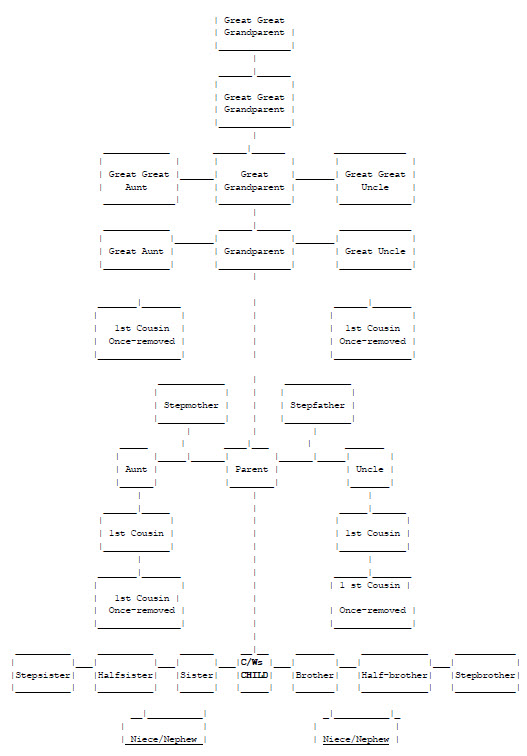|
|
Definition of Relative
A “relative” of a Foster Care child is a person related to the child by virtue of being one of the following:
- The father, mother, brother, sister, half-brother, half-sister, uncle, aunt, first cousin, first cousin once removed, nephew, niece, or any such person of a preceding generation denoted by the prefixes grand-, great-, great-great-, or great-great-great.
- The stepfather, stepmother, stepbrother or stepsister.
- The spouse of any person named above, even after the marriage has been terminated by death or dissolution.
For Foster Care purposes, when a parent's rights to a child are terminated by the filing of a relinquishment with the CDSS or by court action, that parent and his or her relatives are no longer considered to be the child's relatives.
IMPORTANT: The above requirements apply to placements in California. The definition of “relative” varies from state to state. When there is an out-of-state placement, the “host” state's rules apply.
Chart: Caretaker Relatives of a Foster Care Child
Relatives of a Foster Care child include:

All persons listed on this chart are shown in their relationship to the Foster Care child.
Note: “1st Cousin Once Removed” is also extended from both the “Great Aunt” and “Great Uncle.”
Additional Caretaker Relative Criteria
- Caretaker relatives not specifically identified must obtain a foster home license or a RFA certificate in order to receive Foster Care payments for the child in their care, even if they are otherwise exempt from licensing.
- The spouses of blood relatives may be caretaker relatives even if the marriage has ended by death or divorce.
- Once parental rights to a child are terminated, the child's relationship to all other blood relatives also ceases for foster care purposes. (This restriction does not apply to CalWORKs.)
- If a child is adopted, eligible caretaker relatives are limited to the adoptive parent(s) and their relatives as listed above.
When is Grandparent/Grandparent’s Spouse a “Relative”
Use the following chart to determine if a grandparent/grandparent's spouse meets the definition of a caretaker relative.
| IF the child resides with... | Does an AFDC-FC “caretaker relative” relationship exist? |
| The spouse or former spouse of a “natural” grandparent. | Yes |
| The mother and/or father of a stepparent (step-grandparent(s)) |
No (There are no blood ties to the child) |
| The former stepparent who is remarried | Yes |
Documentation of Relative’s Relationship to Child
[EAS 82-808]
The caretaker relative’s relationship to the foster care child must be established and documented in c Case Comments. The relationship must be verified when possible.
The “Foster Care Caretaker Relative Documentation Chart” form (SCD 1383-FC) is used to demonstrate the caretaker relative’s relationship to the child. This completed form must be in the case file. However, alone the SCD 1383-FC does not establish the relative’s relationship to the child.
Acceptable Evidence
The following evidence may be used to verify the relationship of a child to the caretaker relative:
- Adoption papers or records
- Baptismal records of birth and parentage
- Birth certificate
- Bureau of Vital Statistics or local government records of birth and parentage
- Census records
- Church records, including statements from priests, ministers, etc., of parentage or relationship
- Court records of parentage
- Court support records
- Day care center records
- Divorce papers
- Family Bible
- Hospital or public health records of birth and parentage
- Indian census records
- Insurance policy
- Juvenile court records
- Marriage licenses/records
- Outpatient care records maintained by a hospital, clinic, or physician
- Paternity records maintained by a Child Support Agency
- School records
- Voluntary social service agency records.
No Evidence
While the SCD 1383-FC alone is not evidence of the relative’s relationship to the child, it as an affidavit and is used as such when:
- All efforts to obtain other evidence have failed, and
- There is no conflicting evidence, and
- The attempts to obtain the required verification are documented in a CalSAWS journal entry.
When there is conflicting information, obtain sufficient information to support the determination of eligibility.
Mrs. Jones applies for Foster Care as the paternal grandmother of Susan Smith. When the prior case record is reviewed it is noted on the birth certificate that Susan’s father is “unknown.” The paternal grandmother, Mrs. Smith, had previously received CalWORKs for Susan.
The EW asks Mrs. Jones for verification and discovers that there is no relationship between Susan and Mrs. Jones, as Mrs. Jones' son and Susan's mother started dating after Susan was born. In this situation, the caregiver is non-relative and another funding source must be explored.
Definition of Non-Relative
A non-relative is a person whose relationship to the Foster Care child is not within the fifth degree of relatedness, as defined by the state. In order to be entitled to Foster Care payments, a non-relative must be licensed or approved and meet the criteria of an “approved or certified home.”
Related Topics